
Bensu Mini GTR radio controlled car
Review date: 10 October 2002.Last modified 03-Dec-2011.
Radio controlled cars are too big, and too expensive.
Not if you've got a good-sized place to run them and a substantial bank balance, of course. But if you want something you can run on the kitchen floor and buy for the price of a few movie tickets, then you're pretty much out of luck.
Unless you buy one of these.
I've looked at small radio controlled cars before, in my Mini-Z review. Mini-Zs are a good six inches long, though; the Bensu Mini GTR makes a Mini-Z look like a monster truck.
The total length of the Mini GTR's cartoonish body is about 62mm (2.45 inches). This makes it roughly 1/60th to 1/70th scale, depending on the size of the real car you compare it with.
It's about 33mm wide (1.3 inches) at the wing mirrors. Its wheelbase (distance between axles) is about 31mm, and its track (width from one outside wheel edge to the other) is about 30mm.
So it's small.
Very small.
For all its tininess, though, the Mini GTR actually looks pretty nifty. The body is well supplied with vaguely authentic Nissan Skyline coupe paintwork and tiny decals, the plastic wheels have shiny plating, and the tyres are made of real rubber, and removable.
It's also cheap.
The Mini GTR comes packaged like this; this "display case" dome includes everything you need. The whole package costs $AU49.50 from Aus PC Market here in Australia, including batteries and Australian delivery.
[This review's years old now; AusPC don't sell these cars any more.]
The batteries in question can't be adding much to the price, though, because all they are is a pair of AA cells.
The pedestal the Mini GTR comes on is screwed to the battery bay cover of the transmitter, which is round and makes up the bottom of the presentation dome arrangement.
The telescopic antenna comes poked into a hole in the transmitter; you pull it out of there and screw it into the receiver's top before use.
Then you install the batteries, and you're ready to rock and roll.
Ah, you ask, but what about the batteries for the car itself?
No problem. It gets its power from the same AAs that power the transmitter.
To charge the car, you flip back the blue cover on the bottom of the transmitter and clip the car on. Charging takes 45 to 100 seconds, depending on the transmitter's whim and the quality of the contact between the car and the charge point. You should get around five minutes of driving per charge, depending on how and where you drive. The transmitter's four buttons give you only digital control - forwards, backwards, left and right, but no shades of grey - but the little tacker's really quite driveable. Especially if you've ever been forced to play a PC racing game using the keyboard. It's the same deal.
The radio's got enough range that you should be unable to see which way the car's pointing before you're unable to control it; I found control went bad a few times when I chanced upon an unfavourable alignment of the transmitter antenna and the car's own floppy wire aerial, but with the transmitter antenna pointing upwards, everything was generally fine for indoor distances.
Back to the charging for a moment, though. It raises some questions.
Like, "what the heck kind of battery does this thing have, that it can charge in one minute?"
Well, the obvious energy storage device for a baby-car like this is a capacitor, because capacitors can be charged practically instantaneously, and will last for zillions of charge/discharge cycles.
Unfortunately, a capacitor's charge state is directly reflected by its terminal voltage. As you discharge it, its voltage falls. So if you want to power a toy car from one, you either have to put up with steadily dropping performance as the capacitor discharges, or you have to use a regulator that'll eat a considerable amount of power, and greatly reduce run time.
So this car doesn't use a capacitor.
It's easy to remove the Mini GTR's body; it clicks into place over a tab at either end of the chassis. Pop off the blue see-through electronics cover and lift the little circuit board and you can see the battery.
That battery in more detail. It's in a simple friction-fit holder, so it's easy to remove.
The battery doesn't say it's a nickel metal hydride (NiMH) cell, but it has to be, because of its 120 milliamp-hour (mAh) capacity rating. That's way higher than any nickel cadmium (NiCd) cell as small as this "1/4 AAA" one can manage. Even a 1/3 AAA NiCd cell is only likely to manage 50mAh.
If you're wondering how this thing manages to get a full charge into its battery in a minute or two, when the fastest chargers for regular-sized NiMH cells can't get charge time much below two hours, the answer's simple. The Mini GTR doesn't fully charge its battery. It doesn't even come vaguely close to fully charging it. It just whacks it with a pretty high charge current (by the standards of this tiny cell) for a short enough period that no harm's likely to befall the cell, and that's all you get. If you removed the battery and connected it to a suitably gentle outboard charger, you could give it a full charge and, presumably, run the car for ages. But a few minutes of run time will do for most play sessions, particularly given the brief recharge period when you use the transmitter-clip charge method.
Steering servo? We don' need no steenkin' steering servo.
The Mini GTR's steering assembly, here shown disassembled, is based on a couple of coils and a tiny neodymium iron boron magnet, which is moved sideways by the coils when they're energised. A hair-thin spring centres the steering when it's not in use.
This system is simple and works well, but it has the disadvantage that it draws a significant amount of current, by this car's standards. Using lots of steering will noticeably reduce the car's run time, compared with just doing mostly-straight drags up and down the hall.
The steering's rather uncertain even on a dead flat surface, but you can do your best to get it centred with this trim lever on the underside.
The Mini GTR even has suspension, of a sort. The steering knuckles can slide up and down - they're all one piece, but there's a couple of millimetres of vertical play allowed by the length of the pegs that go into the top and bottom mounts. There's a separate spring piece at the top that pushes down on the top of the knuckle peg. Presto - front suspension. There's provision for after-market springs and sway bars as well, may saints preserve us.
The rear end has no suspension at all. Zip. The rear axle just clips into the back of the chassis; you can add a squirt of silicone lube to the clip points for a little more speed.
The rear axle is also solid. If you want a differential in a car this size, you can go whistle. Well, for now, anyway.
The effect of the stock front suspension and rear lack-of-suspension is that the Mini GTR becomes very squirrelly on any even slightly uneven surface. I needed lots of steering input to hold a straight line on the textured linoleum in my kitchen. If you want to go downhill racing, you'll probably need a suspension hop-up or two.
On the subject of hop-ups - if you're not interested in being kind to your weeny-car's motor, you can add more batteries. Dual and even triple battery mods have been performed.
With the standard single battery, the motor that comes in the Bensu car delivers a decent turn of speed. It drives the rear axle through considerable gear reduction, but still has very little torque. The car can run on any smooth surface, but practically any kind of carpet will be heavy going for it, and it can't climb much of a slope.
On smooth linoleum, the Mini GTR I checked out consistently covered the standing 400 centimetres in pretty much exactly four seconds, which is 3.6 kilometres per hour - a hair more than 2.2 miles per hour.
The Mini GTR's run time on short-pile carpet, on which the car could only just get itself moving, was about 90 seconds. This is unrealistically lousy, though; it's the same as driving a regular 1/10th scale electric R/C car through long grass. (If you want to see how hot you can get your model car's battery, you should try that.)
In ordinary mucking-about driving, five minutes per charge seems a reasonable run time. Maybe a bit less, with lots of stop-go driving and steering.
If you just leave a charged Mini GTR sitting about, by the way, it'll lose its charge very quickly. This is presumably because its receiver is running all the time; it has no on/off switch. No big deal, of course; you just have to charge the car right before you run it.
The Mini GTR's performance is good enough for considerable power understeer and handbrake-turning on linoleum, but it isn't that thrilling by teeny-car standards. Which is significant, because this teeny-car is almost exactly the same as several others.
Aficionadoes of tiny R/C cars will, from the above pictures, have realised that this "Bensu" car bears a suspicious resemblance to the Tomy Bit Char-G (called the MicroSizer in the States, and compared with yet another teeny-car in the ExtremeTech piece here).
There are a few other cars around that're this size - the Takara DigiQ for instance. That's quite different in design from everybody else's, since it has no front wheel steering - there's one motor for each rear wheel and they're driven separately to steer.
This odd design apparently works quite well. The DigiQ has proper proportional control, not the simple four-buttons digital control of the other weeny-cars. The DigiQ also isn't actually radio-controlled; it's got an infra-red remote that you have to point at it.
A lot of weeny-cars seem to be Bit Char-G equivalents, though. The Bensu car's extremely similar to the Bit Char-G; the only real difference is the clear electronics cover inside (which is also a feature of "Bullet" brand cars, if this page is to be believed), and the design of the transmitter.
Browsing through the detailed illustrations here of the frankly disturbing number of modifications you can make to these minuscule cars makes the similarity clear. I presume the Bensu cars are made in the same factory, though they may just be a knock-off.
Bit Char-Gs come with four different frequencies, so that's the maximum number of cars you can race against each other. Aus PC Market have only two frequencies of Bensu car in stock at the moment; more may arrive in the future.
At 3.6km/h, the Bensu car is a decent performer by weeny-car standards. It beats the heck out of the stock performance of Bit Char-Gs with their bog standard 10,000RPM ("1.0") motor, but a lot of them have something better.
If Extremetech's numbers are to be believed, the US "MicroSizers" version of this car comes stock with a rather faster motor than the Bensu car has. There's nothing stopping you swapping in another motor yourself, of course; all parts that'll fit a Bit Char-G parts ought to fit the Bensu car as well, and eBay offers tons of cheap options.
Overall
At $AU49.50 delivered with batteries, these cars are a good deal. Easy to carry, ready to play at a moment's notice, and, in case I forgot to mention it before...
...really, really small.
What's not to like?
Recommended.
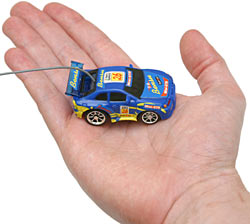
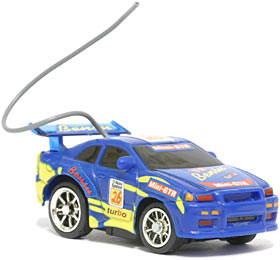
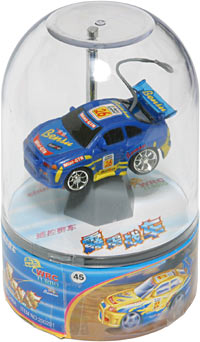
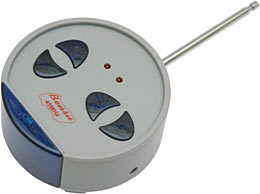
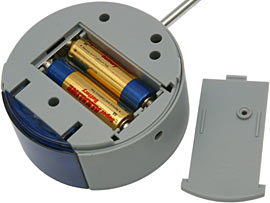
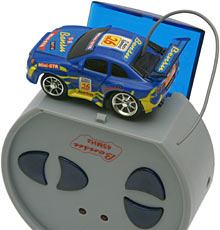
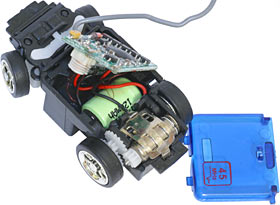
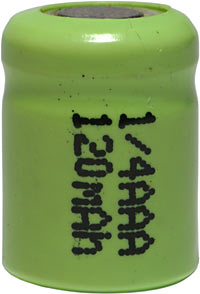
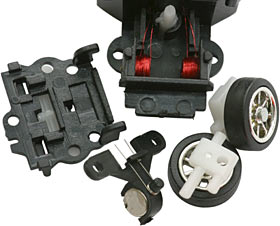
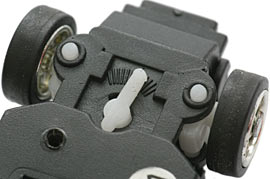
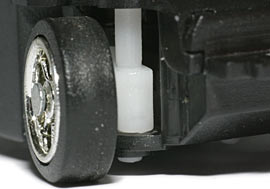
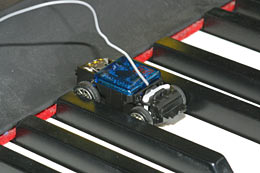

![[SecureWebs]](images/sw.gif)